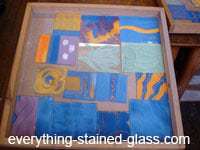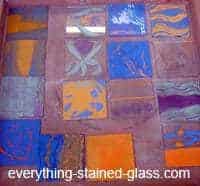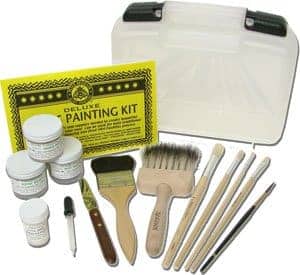How to decorate with paint on wine glasses
I want to teach patients how to paint on wine glasses, so they can decorate glasses that will be suitable for sale to support our Not For Profit Agency. What is the best and safest technique / materials? Ed.
Milly’s reply:
What a fantastic idea Ed! People love hand painted wine glasses, and I bet your patients will enjoy making them.
It’s probably best to start with some cheap glassware – to get the hang of it without spending loads of money…but you can always wash a mistake off if it hasn’t been fired.
First, wash your glass with rubbing alcohol and take care not to touch it. It’s best to have worked out your design before you start, and you can always use carbon paper to transfer it on to the glass if you don’t want to do it freehand.
Once you’ve finished the painting, it’s really important to let it dry to manufacturers’ instructions. Some require just one hour, some twenty four! The glass paint might bubble if you don’t follow the instructions.
Put your glass in a cold oven, heat it to between 300F/150C – 350F/177C and bake it for 30-35mins. Again, read the instructions for the individual paint.
There’s lots of different makes of glass paint – you could try Folk Art acrylic enamel or Pebeo. You don’t say where you’re from, but Pebeo is sold at Michaels and Dick Blicks if you’re from the States. If not, you can get them from an art or stained glass suppliers or from an online catalogue.
The Pebeo is more transparent but takes 24hrs to dry. You might want it more opaque, as it shows more – it depends what you want; I’d advise trying a couple out to see which you like best.
The paint is dishwasher safe once it’s been fired, but it’s best to put them on the top shelf.
Good luck, and send in some photos when you have them – you might even get some web enquiries…
Painting on Mirrors
I am interested in mirror glass painting, but I don’t know much about it. Can you help me by telling mesomething about the type of glass paints to use, and any other thing that would give a good effect?Rabia
Milly’s answer:
Thanks for your question Rabia. Because of the metallic backing on mirrors, you won’t be able to fire any colours on permanently, you’ll have to use what are called ‘cold’ paints. This means that they’re simply painted on at room temperature and left to set. If you tried hard, you could scratch them off – but why would you do that?! They’re perfectly ok for mirrors, although you might have to watch out for condensation in a bathroom situation.
You can buy the paints in a whole range of colours, both transparent and opaque. They’re widely available from stained glass suppliers or craft stores. I’ve used the Pebeo Vitrail range very successfully before. Some people use black paint to create shapes first, and then fill them with different colours, but you don’t have to do this if you don’t like the idea of black ‘outlines’ for each shape.
What else? Have a look at my page on Glass Etching Stencils – they’re very effective on mirrors, or you could learn How To Make Stained Glass and make fantastic coloured glass borders for your mirrors – the real thing!
I hope that gives you some ideas to be getting on with.
How to Prevent Bubbles while glass painting

Coloured Enamel Samples
How do you prevent bubbles while doing glass painting?Uday
Milly’s reply:
Thanks for your question Uday. You normally get bubbles if you are brushing the paint on too thickly, or if the top temperature of your kiln firing schedule is too high.
You need the paint to be the consistency of single cream, and to make sure you have enough on your brush before you start painting. The ideal result pre-firing is a smooth line that isn’t lumpy or watery.
If the pieces of glass you’re firing are small and you’re using a pigment – eg Reusche – you can try the following firing cycle:
200C an hour to 650C. Soak for 5 minutes and then turn your kiln off. Any larger pieces of glass will need annealing.
There’s a series of free Painting On Glass tutorials that take you through the process on my site if you’d like to have a look.
Hope that helps.
Painting Wine Glasses With Glassline
I want to do some wine glass painting. I’m thinking about using Glassline and need a firing schedule to follow? Where would I buy the glass to use? I was going to go to Libbey. Is there a way to know what I will be using? I have a Paragon kiln and also a Olympic larger kiln.
Milly’s reply:
Thanks for your question. I’m afraid I haven’t heard of Glassline – is it a normal glass paint, or something different?
I can help with a firing schedule for wine glasses if you are using the type of glass paint that needs to be fired in a kiln, rather than an oven – they are sometimes called glass enamels. Your Paragon kiln will be perfect. Any glass can be fired in a kiln. The main thing is to make sure that the wine glass isn’t too thick or has a variation in thickness. If it does, it doesn’t mean you can’t fire them, it just means that you have to be a bit slower and more careful with the firing schedule.
Take the kiln up 100 degrees C per hour to 100C, then at 200C per hour to 550C. Turn the kiln off, it should retain enough heat for long enough to anneal naturally.
If you have a thick wine glass, or one with varying thicknesses in the glass, go up 100C ph all the way up to 550C, and control the descent, taking 3 hours to go from 500C to 400C. If the vase is big, take longer to anneal at this stage.
If you need help with how to paint glass, go to my free Painting On Glass tutorials here.
Good luck, I hope that helps.
Painting Starter Kit on Amazon
Peter Mcgrain Deluxe Paint Starter Kit (paid link)



Hello, I have a question which I cannot find the answer to on your Q&A pages. I have a glass rabbit I made, completely flat, and would like to place it on a mirror, could you tell me how I fix it to the mirror? I used your decorative solder idea and it looks great. I will have to work on my solder technique, but you saved the day.
It depends where it’s going on the mirror Tracey. If you place the rabbit by the edge seam in a corner you might be able to solder it to the edges. If not you can stick it on with E6000 glue. Try and pick the darkest parts for gluing as the mirror will reflect the blobs back at you. Good luck.